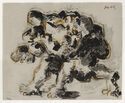
19th, 20th & 21st Century Fine Prints
707-546-7352 · fax 707-546-7924 · web: www.annexgalleries.com · email: artannex@aol.com
Jacques Lipchitz Biography
Jacques Lipchitz
American
1891–1973
Biography
Sculptor and painter Jacques Lipchitz was born Chaim Jacob Lipschitz in Druskininkai, Lithuania, on August 22, 1891. Though his father wished for him to become an engineer, Lipchitz eventually persuaded his parents to let him study art at the Ecole des Beaux-Arts and the Academie Julian in Paris. He arrived in France in 1909 and was soon a part of the Montmartre and Montparnasse artist circles with Juan Gris, Pablo Picasso, and Amedeo Modigliani. Drawn to the avant garde and Expressionist styles developing the internationmal art hub, his work evolved from representational figurative to abstract and eventually to Cubist. At this time he began going by the name Jacques Lipchitz.
He developed a sculpture style he called "Transparents", in which the composition was meant to incorporate the negative space and be seen "through" from several angles in order to interact with the surrounding environment. He worked primarily in stone sculpture and bas-relief, and his first major participation in Paris exhibitions took place at the Salon de la Societe Nationale des Beaux-Arts and the Salon de Automne in 1912. He was given his first solo show at the Galerie L'Effort Moderne in 1920, and had soon established himself as a leading modernist sculptor in Europe. In 1924 he became a naturalized French citizen.
Lipchitz enjoyed success throughout the 1920s and into the mid 1930s. However, with the rise of Nazi Germany, Lipchitz - who was Jewish - had to flee his adopted country as Paris was invaded. Through the American journalist and Resistance collaborator Varian Mackey Fry, he was able to obtain papers for travel to the U.S., and he arrived in New Yorkin 1941. He eventually settled in Hastings-on-Hudson and continued to work and exhibit, and in 1946 he was awarded a Chevalier de la Legion d'Honneur from the French government. In 1954, he was given a major retrospective at the Museum of Modern Art in New York.
Lipchitz remained a U.S. citizen for the rest of his life, but his work took him throughout the world. Though his original success was for his work in Crystal Cubism, he became equally known for his later, more Expressionist figurative works. His interest in Judaism, which had been less of a focus in the first half of his life, became a major influence on his work. He traveled frequently to Italy where he had a home and studio in Tuscany, which would be donated to Chabad-Lubovitch and made into a Jewish summer camp after his death. Lipchitz participated in hundreds of solo and group exhibitions in the U.S., Europe, Israel, Russia, and South America.
Jacques Lipchitz died in Capri, Italy, on May 26, 1973, and was buried in Jerusalem.

